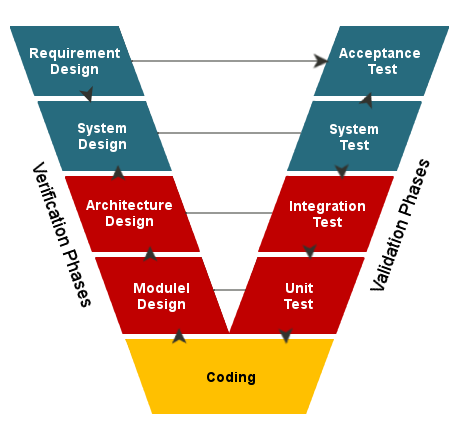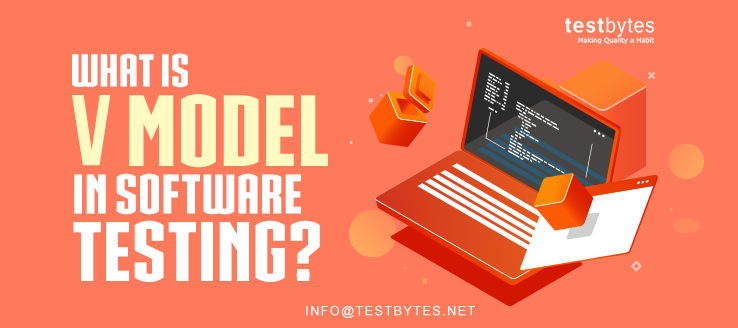Among the many available testing models, the V model in software testing is the most widely used applied and accepted one. This model allows for a better quality analysis with less discretionary errors.
To overcome the cost and time issue of other software testing systems, v model has been developed. In the current scenario, the V model has become famously omnipresent with the software testing and development industry.
The Developmental History of the V model

V model emerged into the existence probably in mid ninety were many research papers have documented about its usage. In 1979 Bart W.
Boehm published a paper where he emphasized on the usage of verification and validation and talk about an appropriate model to manage the drawbacks of the waterfall model.
What is V Model in Software Testing?
V model is also known as verification and validation software model is an SDLC (system development life cycle) and STLC (software testing life cycle) based where main execution process takes place in a sequential manner of v shape.
V model is nothing but the extension of the waterfall model which is based on the association of the development phase and each of the corresponding testing phases.
That means there is a direct link between the testing cycle and the development cycle. V model in software testing is highly specific model and movement to next only occur after completion of the first cycle.

Now let’s have a deeper insight into V model
In the V model, the testing phase and development phase are designed in such a way that they are planned parallel to each other.
So if we take alphabet V there is validation on one end and verification on the other end and the joining point of the both is the coding phase.
In this, the software testing starts at the beginner level right after writing of requirements.
Let us have a look at what is verification and validation.
Validation: It has static analysis or the review technique used without executing code usage. In this stage, the whole thing is about evaluating the product development to find out whether specified requirements of the client are met.
Verification: It involves the dynamic analysis of functional as well as non-functional software, testing is done with the help of executing code. It evaluates the software prepared in the developmental stage to check whether they meet the customer expectation or not.
The testing phase of the V model may include:
- Unit testing:
It is developed in the model designing phase, to eliminate any bug if present.
- Integration testing:
It is performed after completion of unit testing and in this modules are integrated into the system to be tested. This verifies the communication aspect.
- System testing:
It looks after the functional and non-functional requirements.
- User acceptance testing(UAT):
It is performed in the user environment that simply resembles the production unit, in this step it is made sure that the software is ready to be used in the real world.
Advantages of the V model
- Easy to understand and apply, with its flexibility it is easier to manage.
- It is a highly discipline-based model and can be used in specific industries like health.
- As each step is designed in a very rigid and fixed manner so it is much easier to do the review process.
- It is useful in smaller projects where requirements are less and well known.
- Useful in projects where documentation is fixed and no ambiguous technological changes are required.
Significance of the V model
As we all know that the V model is a direct extension of the waterfall model, waterfall model has many drawbacks like
- Testing only starts after implementation is already done.
- It is difficult to work on large projects as key details are subject to being missed out.
- If you make any mistake at any point you must design the whole software to combat the error.
- Architectural defect in the designing and defect introduction.
- Cost of fixing a defect is way too high.
To combat all these point V model of software testing came into existence so that for every development phase there is the testing phase this allows the error to be caught as early as possible.
The left side is the software development cycle and the right side is a software test cycle.
Feature of V model in Software Testing
- Information gathering stage
Have a word with the client and gather as much information as possible. Try to figure out the specifications and details of the software desired to be tested.
- Design
Work on the language script like java or.net and database like Oracle. Try to choose high-level functions which will be the technicality of the project and suits the corresponding software testing well.
- Build stage
After design selections build the coding of the software to be tested, this step is also known as the coding.
- Test stage
Now next test the software to verify that all the requirements are fulfilled.
- Deployment stage
Place the application within the respective environment
- Maintenance
Change the code as per the customer.
Why prefer V model
- Proactive tracking of the defect
The defect can be found in very early stage hence cost is reduced in this model of software testing.
- Have specific deliverables
This makes it easy to review and manage.
- High success rate
When compared with the waterfall model as a developmental test plan are used early in the life cycle of the software chances of success are high.
- Time consumption
In comparison with other models, time consumption is less.
- Manage the resources
It utilities every details aspect of resources available.
- Accommodate changes
As the V model has an incremental approach this permits the prediction of changes required. So changes can be made where it is required.
- Verification planning
Consistent configuration allows early verification, on the other and optimization of the verification can be achieved easily.
- Prevent defect
V model can very well display where validation should be performed, so it makes each artifact to be tested convenient and ensure problem solution. So it perfectly avoids the defect occurs in the operation phase itself.
When to use the V model
- V model is used when a lot of technical support is present also expertise specific are present.
- The requirement of the tester is clearly known and specified.
- When there is time as well as money constraint.
Conclusion
To finish off we can say that there are numerous developmental life cycle models present in the software testing. Selection of the most appropriate model is purely based on the requirement goal and vision of the project.

Also one must remember that testing is no a single entity but it has several layers within it, that has to adapt with each project cycle chosen according to the requirement. Also in any model one should perform testing at all the levels right from the requirement to maintenance.
